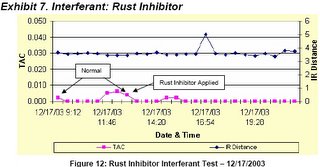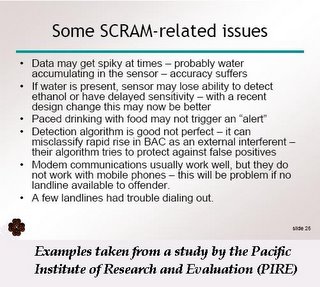LAW and SCRAM: Science and the court=?
http://www.chronicle.duke.edu/vnews/display.v/ART/2006/01/23/43d4d845f2ddf
"Indignant civil libertarians who disapprove of SCRAM bracelets—that’s a Secure Continuous Remote Alcohol Monitor in the form of a less-than-fashionable ankle bracelet, for those not in the know—have perhaps greater reason for their disgust."
Whomever wrote this has an untainted perspective not normally seen in the media-
"We do not deny that the technology is impressive. There exists the potential for this product to be a positive externality for this community and others. We also understand that there is always turbulence when a new-fangled product is introduced. Just look back in time, when now-common polygraphs and house-arrest bracelets were seen as nefarious abuses of technology."
..."Both the bracelet distributors and the monitors of its use are, in North Carolina and in all 32 states that use SCRAM, denizens of a private company. As such, we understand the desire to promote an innovative, potentially lucrative product."
..."Yet there is not yet an established legal precedent for SCRAM use; thus, marketing them as necessary for light sentencing is false advertising. The "experts" that distribute the bracelets can in no way assure defendants of leniency. In some courtrooms, SCRAM use makes a difference. In others, it means nothing. As of right now, there is no jurisprudential consenus."
To follow up the story I found this from: http://www.chronicle.duke.edu/vnews/display.v/ART/2006/01/20/43d0d4b941273
"There are those who say the technology is the most reliable way to keep someone from drinking..." I could not agree more, that is the reason I advocate the use, while opposing the misuse by not informing a defendant with time to offer a toxicology test, if you are going to make a defendant prove their innocents, allow them for the purpose of justice.
"There are many in the judicial system, however, who question the use of a SCRAM as a pre-trial aid intended to win leniency from a judge or as a condition of probation.
Durham District Judge Marcia Morey said defendants who wore the bracelet to show their ability to stay sober after being arrested for a DWI would get "absolutely nothing" in her courtroom. Signing up to wear the bracelet—at an initial cost of $75 and $12 a day after that—is voluntary.
"I would shake my head and say, ‘I’m sorry you’ve wasted all your money,’" Morey said. "It’s not illegal to drink. It’s illegal to drink and drive. If you engage in a lawful activity and you’re not driving, we don’t have the right—we don’t have that authority to monitor you.... It’s like telling a shoplifter you cannot shop."
Craig Brown, another Durham district court judge,said "It was really a more general concern about the private vendors becoming perhaps a bit too aggressive."
Again, rule 702 (admitting scientific evidence) applies, a private company will be far more than zealous when protecting their multi-million dollar investment, do we really need for-profit companies selling the products in the justice system? What will they do to sell and/or protect it? I have yet to perjure myself but for $10,000,000, my childs life, my livelihood, and whatever else I could buy may persuade me to do so, why would they not? It's not just here, this is just another new precedent, PBT's in New Jersey, the people admit DNA! To date there has been a couple of false-positives, ironically DNA proved it, but if the prosecution says," There is a 99.90% chance that he did the crime..." the fact remains that this is one in one thousand, with thousands of people in the community there better be corroborating evidence or I'll be that one jurer, because I know!
I HAVE MORE YET:
The disparity between courtrooms exists in part because there is no state law delineating how SCRAM is to be used. But the Administrative Office of the Courts, the body that officiates the state’s judicial system, has warned judges about the technology.
"We have raised both what we think are legal and programmatic concerns to judges and say we think they should be aware of those concerns when and if they use the technology," said Greg Stahl, senior deputy director of the AOC.
Stahl also called into question the veracity of the science behind the bracelets, saying that the only testing he had read about was done by a company hired by SCRAM’s manufacturer.
"Recently judges in both Florida and Michigan have found the device to be unreliable," he said. "All our other devices that have to do with alcohol or drugs are monitored by Health and Human Services. There’s no such regulation for this device."
http://www.chronicle.duke.edu/vnews/display.v/ART/2006/01/20/43d0d4b941273
"Indignant civil libertarians who disapprove of SCRAM bracelets—that’s a Secure Continuous Remote Alcohol Monitor in the form of a less-than-fashionable ankle bracelet, for those not in the know—have perhaps greater reason for their disgust."
Whomever wrote this has an untainted perspective not normally seen in the media-
"We do not deny that the technology is impressive. There exists the potential for this product to be a positive externality for this community and others. We also understand that there is always turbulence when a new-fangled product is introduced. Just look back in time, when now-common polygraphs and house-arrest bracelets were seen as nefarious abuses of technology."
..."Both the bracelet distributors and the monitors of its use are, in North Carolina and in all 32 states that use SCRAM, denizens of a private company. As such, we understand the desire to promote an innovative, potentially lucrative product."
..."Yet there is not yet an established legal precedent for SCRAM use; thus, marketing them as necessary for light sentencing is false advertising. The "experts" that distribute the bracelets can in no way assure defendants of leniency. In some courtrooms, SCRAM use makes a difference. In others, it means nothing. As of right now, there is no jurisprudential consenus."
To follow up the story I found this from: http://www.chronicle.duke.edu/vnews/display.v/ART/2006/01/20/43d0d4b941273
"There are those who say the technology is the most reliable way to keep someone from drinking..." I could not agree more, that is the reason I advocate the use, while opposing the misuse by not informing a defendant with time to offer a toxicology test, if you are going to make a defendant prove their innocents, allow them for the purpose of justice.
"There are many in the judicial system, however, who question the use of a SCRAM as a pre-trial aid intended to win leniency from a judge or as a condition of probation.
Durham District Judge Marcia Morey said defendants who wore the bracelet to show their ability to stay sober after being arrested for a DWI would get "absolutely nothing" in her courtroom. Signing up to wear the bracelet—at an initial cost of $75 and $12 a day after that—is voluntary.
"I would shake my head and say, ‘I’m sorry you’ve wasted all your money,’" Morey said. "It’s not illegal to drink. It’s illegal to drink and drive. If you engage in a lawful activity and you’re not driving, we don’t have the right—we don’t have that authority to monitor you.... It’s like telling a shoplifter you cannot shop."
Craig Brown, another Durham district court judge,said "It was really a more general concern about the private vendors becoming perhaps a bit too aggressive."
Again, rule 702 (admitting scientific evidence) applies, a private company will be far more than zealous when protecting their multi-million dollar investment, do we really need for-profit companies selling the products in the justice system? What will they do to sell and/or protect it? I have yet to perjure myself but for $10,000,000, my childs life, my livelihood, and whatever else I could buy may persuade me to do so, why would they not? It's not just here, this is just another new precedent, PBT's in New Jersey, the people admit DNA! To date there has been a couple of false-positives, ironically DNA proved it, but if the prosecution says," There is a 99.90% chance that he did the crime..." the fact remains that this is one in one thousand, with thousands of people in the community there better be corroborating evidence or I'll be that one jurer, because I know!
I HAVE MORE YET:
The disparity between courtrooms exists in part because there is no state law delineating how SCRAM is to be used. But the Administrative Office of the Courts, the body that officiates the state’s judicial system, has warned judges about the technology.
"We have raised both what we think are legal and programmatic concerns to judges and say we think they should be aware of those concerns when and if they use the technology," said Greg Stahl, senior deputy director of the AOC.
Stahl also called into question the veracity of the science behind the bracelets, saying that the only testing he had read about was done by a company hired by SCRAM’s manufacturer.
"Recently judges in both Florida and Michigan have found the device to be unreliable," he said. "All our other devices that have to do with alcohol or drugs are monitored by Health and Human Services. There’s no such regulation for this device."
http://www.chronicle.duke.edu/vnews/display.v/ART/2006/01/20/43d0d4b941273



